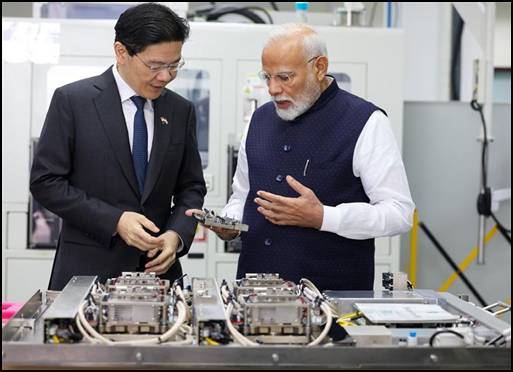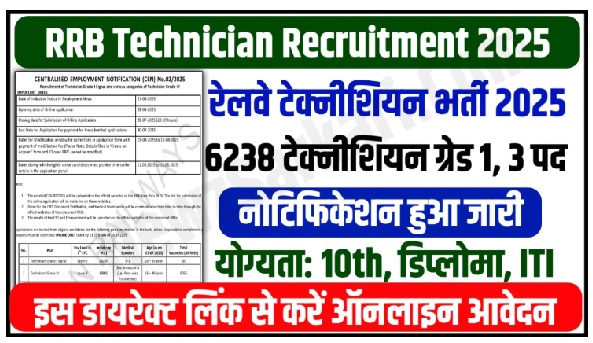Over the past eleven years, India has undergone a remarkable technological transformation, seamlessly integrating digital solutions into daily life and governance. This journey has been driven by visionary leadership, focusing on empowering every citizen, especially in rural and underserved areas. From digital finance to space exploration, technology has become the cornerstone of India’s growth, positioning the nation as a frontrunner in the digital age.
Digital Finance and Inclusion: A Revolution in Payments
Technology has brought financial services closer to millions, particularly in rural and remote regions. The Unified Payments Interface (UPI) has revolutionized digital transactions. In March 2025 alone, UPI facilitated over 18,301 million transactions valued at ₹24.77 lakh crore. This widespread adoption means close to 460 million individuals and 65 million merchants now use UPI. India’s leadership in digital payments is evident as it accounted for 49% of global real-time transactions in 2023.
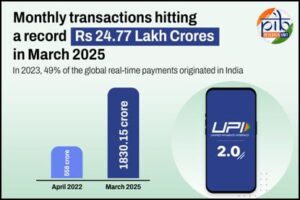
Aadhaar, with over 141.88 crore IDs generated as of April 2025, has become a vital part of India’s digital backbone, simplifying processes in banking and public services by enabling faster verification and reducing paperwork.

The Direct Benefits Transfer (DBT) system, supported by Aadhaar, has significantly streamlined welfare delivery, preventing leakages and ensuring that over ₹43.95 lakh crore has been transferred directly to beneficiaries as of May 2025. This has also led to the removal of 5.87 crore ineligible ration card holders and 4.23 crore duplicate LPG connections, making the welfare system more transparent.
Connectivity and Infrastructure: Building a Robust Digital Backbone
India’s digital push is built on a strong foundation of expanded mobile networks and rural internet access. The rapid expansion of 4G coverage since 2016 and the subsequent arrival of 5G in October 2022 have significantly improved connectivity. India achieved one of the fastest 5G rollouts globally, with 4.74 lakh 5G Base Transceiver Stations (BTSs) set up in just 22 months, and 5G services now cover 99.6% of the country’s districts. This infrastructure supports a mobile subscriber base of 116 crore in 2025.

Accompanying this growth is a drastic reduction in mobile data costs, from ₹308 per GB in 2014 to just ₹9.34 in 2022, making digital services far more accessible and affordable. The BharatNet project has further extended high-speed internet to over 2.14 lakh Gram Panchayats, laying nearly 6.93 lakh km of optical fibre cable.
Public Service Delivery and Governance: Empowering Citizens
Technology has transformed how citizens interact with the government, making services faster, more transparent, and easier to access. The Co-WIN portal, for instance, served as India’s digital backbone for managing over 220 crore COVID-19 vaccine doses, showcasing transparency and efficiency on a global scale.
Common Services Centres (CSCs) are another testament to grassroots digital empowerment, with 5.97 lakh CSCs operational across the country as of January 2025, providing a wide range of services from banking to telemedicine in rural areas.
Digital Capacity Building: Equipping for a Digital-First Future
Beyond access, India is focusing on enabling people and institutions to effectively use technology. BHASHINI, an initiative under the National Language Translation Mission, supports over 35 languages with 1,600+ AI models, bridging linguistic divides and making digital content and public services accessible in multiple Indian languages. It has over 8.5 lakh mobile app downloads and is integrated into platforms like IRCTC and NPCI’s IVRS systems.

The Pradhan Mantri Gramin Digital Saksharta Abhiyan (PMGDISHA) successfully trained 6.39 crore individuals in basic digital literacy, surpassing its goal and becoming one of the world’s largest digital literacy campaigns. Furthermore, Karmayogi Bharat, under Mission Karmayogi, is upskilling civil servants through the iGOT Karmayogi portal, with over 1.07 crore Karmayogis onboarded and 2,588 courses offered as of May 2025.
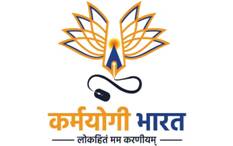
Advancing Strategic Tech Capabilities: Towards Self-Reliance and Innovation
India is also making significant strides in building self-reliance and fostering innovation in strategic technological areas. The IndiaAI Mission, approved with an outlay of ₹10,371.92 crore, aims to build a comprehensive AI ecosystem, focusing on compute capacity, innovation, datasets, application development, future skills, startup financing, and safe AI. As of May 2025, India’s national compute capacity has exceeded 34,000 GPUs.

The India Semiconductor Mission, with a ₹76,000 crore outlay, is building a robust semiconductor and display manufacturing ecosystem. Six semiconductor manufacturing projects have been approved with investments over ₹1.55 lakh crore, and five units are in advanced stages of construction. This includes a joint venture between HCL and Foxconn for a display driver chip manufacturing plant.
In defence, India recorded its highest-ever production value of ₹1,27,434 crore in FY 2023-24, a 174% increase from 2014-15. This surge is fueled by indigenous platforms and the introduction of Positive Indigenisation Lists restricting import of over 5,500 defence items, leading to the indigenisation of over 3,000 items by February 2025.
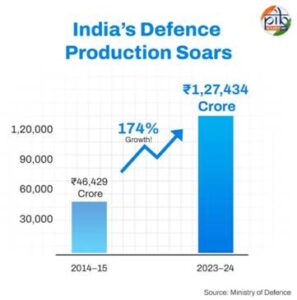
Leadership in Space: Unravelling Lunar Mysteries
India’s space journey has garnered global respect. ISRO set a world record by launching 104 satellites in a single mission in 2017. The Chandrayaan-3 mission achieved a historic soft landing near the lunar south pole in July 2023, making India the first country to do so. August 23rd is now celebrated as National Space Day in honor of this achievement. India’s space budget has crossed ₹13,000 crore, reflecting a growing commitment to space exploration.
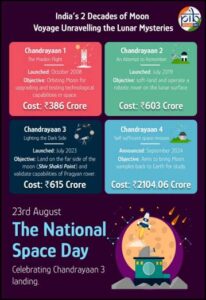
Future plans include launching the Bharatiya Antariksh Station by 2035, conducting the first human spaceflight mission in 2027, and planning a manned Moon mission by 2040. The Gaganyaan Programme, with an outlay of approximately ₹20,193 crore, is set to make India’s first human spaceflight a reality, with four Indian Air Force test pilots already selected and trained.
Conclusion
India’s technological odyssey over the last eleven years exemplifies the power of focused leadership and smart technology utilization. From digital services reaching remote villages to groundbreaking achievements in space, innovation has been instrumental in bridging gaps and unlocking new opportunities. This strong digital foundation will continue to propel India’s progress, ensuring that people remain at the core of its technological ascent

